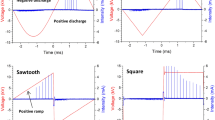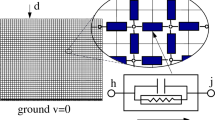Abstract
LUMINOUS corona discharges occur when transient voltages, lasting about a microsecond, are applied between a wire and a small coaxially mounted ring in air. I have photographed these discharges and find that their shapes differ with the polarity of the electrodes. When the wire is made the negative electrode the discharge has the form of diffuse tufts, which are grouped around the wire into a roughly symmetrical brush; when positive, the discharge occurs in radial filaments (Figs. 1 and 2). Viewed along the axis the shape of a corona discharge resembles the Liehtenberg figure corresponding to the same polarity, which is produced by a discharge in air on an insulating surface between concentric electrodes1 (Figs. 3 and 4).
This is a preview of subscription content, access via your institution
Access options
Subscribe to this journal
Receive 51 print issues and online access
$199.00 per year
only $3.90 per issue
Buy this article
- Purchase on Springer Link
- Instant access to full article PDF
Prices may be subject to local taxes which are calculated during checkout
Similar content being viewed by others
References
Merrill and von Hippel, J. App. Phys., 10, 891 (1939).
Looms, Report to B.E.A.I.R.A., S/B/T.124 (1955).
Bellaschi and Teage, Elect. Eng., 53, 1638 (1934).
Bowdler and Standring, J. Inst. Elect. Eng., 88, II, 5 (1941).
Author information
Authors and Affiliations
Rights and permissions
About this article
Cite this article
LOOMS, J. Electrical Discharges between Coaxial Electrodes. Nature 181, 696–697 (1958). https://doi.org/10.1038/181696a0
Published:
Issue Date:
DOI: https://doi.org/10.1038/181696a0
Comments
By submitting a comment you agree to abide by our Terms and Community Guidelines. If you find something abusive or that does not comply with our terms or guidelines please flag it as inappropriate.



